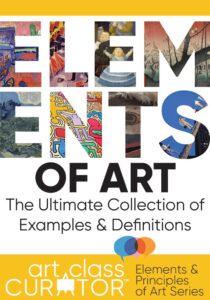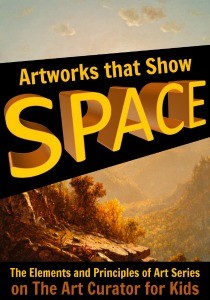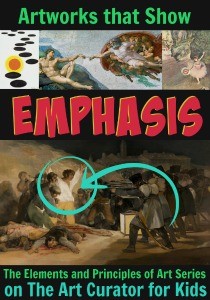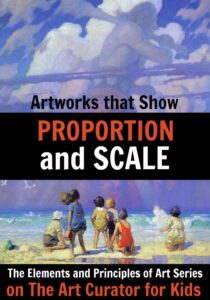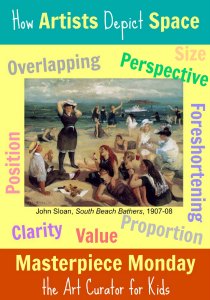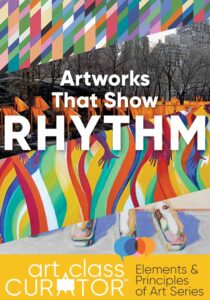It’s time again for an Elements and Principles of Art post! This post includes good examples of color in art, divided into categories. This list of examples of color in art contains the following elements of color: warm and cool colors in art, primary color art, complementary colors in art, analogous colors examples, neutral colors in art, and color intensity in art.
Want to check out my color wheel lesson on Color in Art? Click here to purchase the color in art and color wheel lesson.
Download the Free Elements and Principles Printable Pack

This pack of printables was designed to work in a variety of ways in your classroom when teaching the elements and principles of art. You can print and hang in your classroom as posters/anchor charts or you can cut each element and principle of art in its own individual card to use as a lesson manipulative.
Examples of Color in Art
Primary Color Art
The primary colors are red, yellow, and blue. The primary colors are the basis for all other colors. You cannot do anything to mix blue, yellow, or red. They just exist.
- Piet Mondrian, Broadway Boogie Woogie, 1942-43
- Mark Rothko, Untitled (Yellow, Red, and Blue), 1953
- Jacob Lawrence, Workshop (Builders #1), 1972 and many others
- Cy Twombly, Summer Madness, 1990 (Click link, then click #20)
- Hans Hofmann, The Golden Wall, 1961
- Pablo Picasso, Claude and Paloma Playing, 1950
- Fritz Glarner, Relational Painting No. 64, 1953
- Roy Lichtenstein, Stepping Out, 1978
- Ancient Roman, Glass Garland Bowl, late 1st century B.C.E.
- Henri de Toulouse-Lautrec, Ambassadeurs Aristide Bruant in his cabaret, 1892
- Nicolas Poussin, The Death of Germanicus, 1627
Complementary Colors in Art
Complementary colors in art are opposite each other on the color wheel. They create a lot of contrast in art. Look around in the world, and you will be surprised how often complementary colors are used. What are the sets of complementary colors? The basic complementary color pairings are red and green, purple and yellow, and orange and blue.
- Wassily Kandinsky, Improvisation 31 (Sea Battle), 1913
- Pablo Picasso, Woman in Striped Armchair, 1941
- Rufino Tamayo, Women of Tehuantepec, 1939, Oil on canvas
Complementary Colors in Art – Red and Green
- Marc Chagall, I and the Village, 1911
- Ando Hiroshige, Plum Estate, Kameido From “One Hundred Famous Views of Edo”, 1857
- Shinobo Ishihara, Test for Color Deficiency
- Vincent van Gogh, The Night Café, 1888
- Jan van Eyck, The Arnolfini Portrait, 1434
- Henri Matisse, Portrait of Madame Matisse (Green Stripe), 1905
- Pablo Picasso, Woman with Hat, 1962
- Georgia O’Keeffe, Anything, 1916 (Click link, top right image)
- Vincent van Gogh, La Berceuse (Woman Rocking a Cradle; Augustin-Alix Pellicot Roulin, 1851-1930), 1889
- Kay Kurt, Weingummi II, 1973
Complementary Colors in Art – Blue and Orange
- Mary Cassatt, Mother and Child, 1890
- Edgar Degas, Ballerina and Lady with Fan, 1885
- Claude Monet, Rouen Cathedral, West Façade, Sunlight, 1892
- Paul Klee, Ad Parnassum, 1932
- Vincent van Gogh, Self-Portrait, 1889
- Claude Monet, Impression, Sunrise, 1872
- Fritz Bultman, Blue I, 1958
- Henri de Toulouse-Lautrec, Portrait of Oscar Wilde, 1895
- Sandy Skoglund, Revenge of the Goldfish, 1981
- Stuart Davis, Colonial Cubism, 1954
- Edvard Munch, The Scream, 1893
- Arnold Böcklin, Island of the Dead, 1880
Complementary Colors in Art – Purple and Yellow
- Claude Monet, Water Lilies, 1914-1926
- Fritz Scholder, Dream Horse G, 1986
- Henri Matisse, The Dream, 1940
- Pablo Picasso, Woman with Yellow Hair, 1931 (also red/green)
- Ray Spillenger, Purple and Yellow, 1963
- Francis Bacon, Study after Velázquez’s Portrait of Pope Innocent X, 1953
- Federico Barocci, The Nativity, c. 1597
- Mark Rothko, Untitled, 1954
 Analogous Colors Examples
Analogous Colors Examples
Analogous colors are next to each other on the color wheel. They create unity in art because they are made of the same colors. Example sets of analogous colors are blue, blue-green, and green or orange, red-orange, and red.
- Josef Albers, Homage to the Square: Soft Spoken, 1969
- Vincent van Gogh, The Olive Trees, 1889
- Claude Monet, The Water-Lily Pond, 1899
- Mark Rothko, Untitled (Violet, Black, Orange, Yellow on White and Red), 1949
- Helen Frankenthaler, Freefall, 1992
- Ed Paschke, Painted Lady, 1995
- Giorgio de Chirico, Mystery and Melancholy of a Street, 1914
- Jean-Honoré Fragonard, Young Girl Reading, c. 1770
- Geertgen Tot Sint Jans, John the Baptist in the Wilderness, ca. 1490
Warm and Cool Colors in Art
Warm colors are the colors red, orange, and yellow. They are bright and pop out. They create energy and excitement in an artwork. Blue and green are cool colors. These cool colors create a calming energy in an artwork. Violet/purple can be both warm and cool depending on how much red or how much blue is in the violet.
Warm Colors in Art
- Vincent van Gogh, Sunflowers, 1888
- Paul Gauguin, Still Life with Mangoes, 1891-1896
- Mark Rothko, Untitled (Violet, Black, Orange, Yellow on White and Red), 1949
- Vincent van Gogh, The Night Café, 1888
- Robert Adam, The Croome Court tapestry room, Worcestershire, 1758-67
- Frederic Church, Cotopaxi, 1862
- Caravaggio, The Incredulity of Saint Thomas, 1601-1602
 Cool Colors in Art
Cool Colors in Art
- Claude Monet, The Artist’s Garden at Giverny, 1900
- Winslow Homer, Fishing Boats, Key West, 1903
- Richard Parkes Bonington, The Undercliff, 1828
- James McNeil Whistler, Nocturne, Blue and Silver: Chelsea, 1871
- Natalya Goncharova, Linen, 1913
- Katsushika Hokusai, 36 Views of Mount Fuji, ca. 1829-32
 Neutral Colors in Art
Neutral Colors in Art
Neutral colors are created by using white and black or are created by mixing sets of complementary colors together to make varying shades of brown. Examples of neutrals include gray, brown, tan, white, black, etc.
- El Lissitzky, Proun 19D, c. 1922
- Claude Monet, Sunrise (Marine), 1873
- Georgia O’Keeffe, Black Iris, 1926
- Camille Pissarro, Place du Théâtre Français, Paris: Rain, 1898
- Marcel Duchamp, Nude Descending a Staircase, No. 2, 1912
Color Intensity in Art
Intensity refers to how saturated a color is. It is the brightness or the dullness of a color. Colors with high intensity are bright, and colors with low intensity are dull.
Color Intensity in Art: High Intensity
- Pablo Picasso, The Weeping Woman, 1937
- Andre Derain, Charing Cross Bridge, 1906
- Ernst Ludwig Kirchner, Seated Girl (Fränzi Fehrmann), 1910
- Jim Dine, The Circus #3, 2007
Color Intensity in Art: Low Intensity
- Salima Hashmi, Poem for Zainab, 1994
- Paul Klee, Hammamet with Its Mosque, 1914
- Henri de Toulouse-Lautrec, Moulin Rouge The Departure of the Quadrille, 1892
- Camille Pissarro, Place du Théâtre Français, Paris: Rain, 1898
- Helen Frankenthaler, Mountains and Sea, 1952
Do you have a great example to teach color in art? Share it with me in the comments, and I will add it to the list!

Elements and Principles Teaching Bundle
This extraordinary bundle includes the best resources for teaching each of the elements and principles—37 worksheets/handouts, 15 lessons (with accompanying PowerPoints and Handouts), 3 ready-to-go art analysis activities, 3 art analysis videos, and 13 elements and principle PDF articles.
For more elements of art examples and principles of design examples, visit the following resources.
